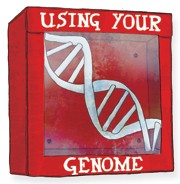My genome. So what? (original) (raw)
Research is needed into the way individuals use their genomic information, and into protection from its abuse by others.

Human genome research has proved itself predictably unpredictable. As was widely anticipated, the speed of sequencing has escalated, the pace of linking genes to disease has quickened, and practically anyone can have their genome investigated and fed back to them in electronic format to do with it what they will. In this issue, two groups reveal individual genome sequences of a Yoruba man from Ibadan, Nigeria (see page 53), and of a Han Chinese individual (see page 60) for a cost of less than US$500,000 each — a fraction of that of the human genome's first drafts or subsequently published editions.
The age of personal genomes is here. What many promoters of genomics did not predict are the challenges that individuals face in using this information. One is the limited extent to which the genetic constitution revealed says anything about future health. The predictive value of genetic associations has fallen short of some expectations, often in dramatic ways (see page 18), and fails to augment in any meaningful way more traditional predictors for health, such as lifestyle and family history.
Another largely unpredicted outcome were the private companies that sprang up to capitalize on these genetic clues, selling individuals genotype information and predictions about health based on the incomplete information available. Yet more services are now springing up to help people make sense of the data (see page 11). It's obvious that this genetic fortune-telling will be murky and inconclusive for many years to come. What is not clear is how people will act on it. However questionably, these companies are blazing a trail that could provide insight into ways in which people interact with these sensitive personal data. Researchers should look for more ways to investigate these consumer interactions from the perspective of public health, social sciences and potential biomedical applications.
One predicted outcome of human genome sequencing was the stocking of the drained pipelines of pharmaceutical companies with drug targets in the hope of ultimately developing cures for common afflictions. Although there have been some rousing signs of success, the refrain is that the complexity of the problem requires more data and more research (see page 26). Personal genomes may have a useful role: more human sequences complete with thorough medical histories and information about the environments in which the individuals grew up and lived will be the richest source of data to understand the genetic underpinnings of disease.
But making such information easily available to researchers has predictably challenged valued principles of privacy. Current protection for research subjects is inadequate in this respect (see page 32). In the United States, the Genetic Information Nondiscrimination Act of 2008 provides safeguards against discrimination by employers and health-insurance companies but does not protect against other potential misuse, including intrusion by law-enforcement agencies. Anonymizing data is not the answer, as re-identification of anonymous data can be easy. And researchers' discretion cannot be relied on.
Notions of privacy are changing — many people seem quite willing to share information about their genomes and medical histories. But researchers could make better use of available ways of protecting the privacy of their research subjects. Certificates of confidentiality in the United States give researchers the right to refuse disclosure to any civil authority of any information that could identify a subject, and are one example of a possibly underused protection. Researchers need to collaborate with social scientists, legal experts and regulators to improve on such models, both for the current challenges to privacy that personal genomes pose and for challenges that have yet to present themselves. We can't predict everything that will happen next, but we can be prepared.